Mastering LinkedIn Networking for US Career Growth (2025 Guide)

This comprehensive guide provides an updated roadmap for professionals in the US looking to leverage LinkedIn for enhanced career growth through strategic and effective networking techniques in 2025.
In today’s dynamic job market, a robust professional network is more than an asset; it’s a necessity. This guide, The Ultimate Guide to Mastering LinkedIn Networking for Career Growth in the US (Updated January 2025), is designed to empower you with the strategies and insights needed to transform your LinkedIn presence into a powerful engine for career advancement.
Understanding the LinkedIn Ecosystem in 2025
LinkedIn has evolved far beyond a simple online resume platform; in 2025, it stands as the preeminent professional networking hub globally, particularly within the US career landscape. Its sophisticated algorithms and widespread adoption make it an indispensable tool for job seekers, recruiters, and industry leaders alike. Grasping its nuances is key to unlocking its full potential for your career trajectory.
The platform’s continuous updates mean that strategies that worked even a year ago might be less effective now. Professionals need to stay abreast of new features, algorithm changes, and best practices to ensure their efforts yield maximum return. This involves more than just a complete profile; it demands active engagement and a strategic approach to interactions.
The Evolving Landscape of Professional Networking
Networking on LinkedIn in 2025 is less about collecting connections and more about cultivating meaningful relationships. This shift emphasizes quality over quantity, urging users to focus on genuine interactions that foster mutual benefit. It’s about building a reputation, sharing expertise, and becoming a recognized authority in your field.
- Content Dominance: High-quality, original content creation is paramount for visibility.
- Personal Branding: Your profile is your digital business card; optimize it for impact.
- Authentic Engagement: Move beyond likes and share thoughtful comments and insightful posts.
The platform’s analytics also provide valuable insights into who is viewing your profile, what content resonates most, and how your network is growing. Utilizing these data points allows for continuous refinement of your networking strategy, ensuring your efforts are always aligned with your career objectives. Understanding demographic trends within your target industries can further inform your approach.
Leveraging LinkedIn’s Advanced Features
Beyond basic profile setup, LinkedIn offers a plethora of features designed to enhance networking capabilities. These include specialized groups, article publishing, live events, and the often-underestimated “Skills & Endorsements” section. Mastering these tools can significantly amplify your professional reach and impact.
The “Creator Mode” is especially powerful for establishing thought leadership, allowing you to highlight specific interests and gain followers more readily. Furthermore, LinkedIn Learning offers opportunities to acquire new skills and display them directly on your profile, making you more attractive to potential employers and collaborators. These features are constantly being refined, demanding regular exploration.
In summary, a deep understanding of LinkedIn’s current ecosystem is the foundational step toward effective networking. It requires a blend of strategic planning, proactive engagement, and continuous adaptation to the platform’s evolving functionalities. Your presence shouldn’t be static; it should be a living, breathing representation of your professional journey and aspirations.
Optimizing Your LinkedIn Profile for Maximum Impact
Your LinkedIn profile serves as your digital resume, portfolio, and personal brand statement, all rolled into one. In the competitive US job market of 2025, a meticulously optimized profile isn’t just an advantage; it’s a prerequisite. Recruiters and hiring managers often make snap judgments based on what they see, making every section critical.
A well-crafted profile goes beyond listing your work history; it tells your professional story, showcasing your unique value proposition. It should be dynamic, keyword-rich, and tailored to the types of opportunities you seek. This proactivity demonstrates an understanding of modern recruitment practices and attention to detail.
Crafting a Compelling Headline and Summary
Your headline is arguably the most crucial element after your profile photo. It’s the first thing people see in search results and directly impacts whether they click to learn more. It should be more than just your current job title; it should convey your expertise and your professional aspirations using relevant keywords.
- Keyword-Rich Headline: Include your target role, industry, and key skills.
- Engaging Summary: Use storytelling to highlight achievements and career goals.
- Call to Action: Briefly mention what you are looking for or how you can add value.
The summary section is your opportunity to expand on your headline, offering a more narrative and detailed overview of your capabilities, passions, and career journey. Think of it as a brief, compelling introduction that encourages further exploration of your profile. It should be written in the first person, making it personal and authentic.
Showcasing Experience and Skills Strategically
When detailing your experience, move beyond simple job descriptions. Quantify your achievements whenever possible, using metrics and specific examples to demonstrate impact. Instead of “managed projects,” write “managed 10+ cross-functional projects, resulting in X% efficiency gain.” This provides concrete evidence of your contributions.

The “Skills & Endorsements” section is another powerful tool for both visibility and credibility. Populate this section with a diverse range of skills, from technical competencies to soft skills. Actively seek endorsements from colleagues and managers who can vouch for your abilities, as these add significant weight to your profile.
Furthermore, consider leveraging the “Volunteering Experience” and “Accomplishments” sections to highlight additional facets of your professional persona. This might include certifications, publications, patents, or awards. Any element that contributes to a holistic and impressive portrayal of your professional journey should be included.
In essence, an optimized LinkedIn profile is a living document that requires ongoing attention. Regular updates ensure it accurately reflects your evolving skill set and career aspirations, positioning you as a highly attractive candidate in the dynamic US job market.
Building a Strategic Network: Quality Over Quantity
In the realm of LinkedIn networking for career growth in the US, the adage “it’s not what you know, but who you know” resonates profoundly, but with a crucial twist: it’s about the quality of those connections, not just the quantity. A network of genuinely engaged and relevant contacts holds far more value than a vast collection of superficial connections.
Strategic networking involves identifying individuals who can genuinely contribute to your career objectives, whether through mentorship, job opportunities, knowledge sharing, or partnership prospects. This focused approach ensures your efforts are efficient and yield more meaningful relationships.
Identifying and Connecting with Key Individuals
Before sending out invitations, clearly define your networking goals. Are you looking for a new job in a specific industry, seeking expert advice, or exploring potential collaborations? Your objectives will guide your search for relevant contacts. Utilize LinkedIn’s advanced search filters to pinpoint individuals by industry, role, company, or geographic location.
When sending connection requests, always personalize your message. Generic requests are often ignored. Reference a shared connection, a piece of their content you admired, or a common interest. A personalized note demonstrates thoughtfulness and increases the likelihood of acceptance, setting the stage for a more meaningful interaction.
Cultivating Relationships Beyond the Connection
Making a connection is merely the first step; the real work lies in nurturing that relationship. This involves ongoing, genuine engagement, not just when you need something. Regularly check in, share relevant articles, offer advice, or congratulate them on their achievements. These small gestures build rapport and demonstrate sustained interest.
- Thoughtful Engagement: Comment on posts, share insights, and congratulate successes.
- Offer Value First: Think about how you can help or support your connections.
- Offline Interactions: Move conversations to email or virtual calls for deeper discussion.
Consider joining relevant LinkedIn groups where you can participate in discussions, answer questions, and establish yourself as an expert in your field. These groups often house highly targeted networks of professionals with shared interests, providing fertile ground for meaningful connections. Active participation enhances your visibility and credibility.
Remember that strategic networking is a long-term investment. It’s about building a robust web of professional relationships that can support your career journey over time, rather than a quick fix for immediate needs. By prioritizing quality and genuine interaction, your LinkedIn network can become an invaluable asset for sustained career growth in the US.
Engaging with Content and Becoming a Thought Leader
Beyond building connections, active engagement with content and becoming a recognized thought leader are paramount for sustained career growth on LinkedIn in 2025. This involves more than just consuming information; it means contributing valuable insights, initiating discussions, and consistently sharing expertise that resonates with your target audience.
A strong personal brand, cultivated through thoughtful content and engagement, positions you as an authoritative figure in your industry. This, in turn, attracts opportunities, collaborations, and a wider network of professionals eager to connect with someone of your caliber.
Sharing Relevant and Original Content
Content is king on LinkedIn. Consistently sharing relevant and original content is one of the most effective ways to increase your visibility and demonstrate your expertise. This could include articles, short posts, videos, or even curated news from your industry. The key is to provide value to your network.
When creating content, aim for authenticity and insight. Share your unique perspectives on industry trends, best practices, or challenges. Don’t be afraid to voice your opinions, but always do so in a professional and constructive manner. Consistency in your publishing schedule helps maintain audience engagement and algorithmic visibility.
Actively Engaging on the Platform
Engagement isn’t a passive activity; it requires proactive participation. Comment on others’ posts, ask insightful questions, and respond thoughtfully to comments on your own content. These interactions show that you are an active member of the community and foster deeper connections.

- Thoughtful Comments: Go beyond “Great post!” and add value with your insights.
- Ask Questions: Encourage dialogue and demonstrate curiosity.
- Respond Promptly: Keep conversations going and acknowledge engagement.
Participate in LinkedIn Live events, webinars, and polls. These features offer real-time opportunities to interact with industry leaders and peers, expanding your network and showcasing your expertise in a dynamic setting. The more you engage, the more visible you become to relevant professionals and recruiters who are looking for active, knowledgeable contributors.
Moreover, consider the power of endorsements and recommendations. Offering a genuine endorsement or writing a thoughtful recommendation for a colleague can strengthen your bond and often lead to reciprocal actions. These gestures reinforce your standing as a supportive and valued member of the professional community.
In conclusion, becoming a thought leader on LinkedIn is a journey that combines consistent content creation with genuine, active engagement. By sharing your knowledge and fostering meaningful interactions, you not only elevate your personal brand but also open doors to unparalleled career opportunities in the US market.
Leveraging LinkedIn for Job Search in the US
For professionals in the US, LinkedIn has become the definitive platform for job searching in 2025. It offers far more than just job postings; it provides a comprehensive toolkit for identifying opportunities, connecting with recruiters, and researching companies. Mastering its job search features can significantly accelerate your career transition.
Successful job searching on LinkedIn requires a proactive and strategic approach, combining profile optimization with active engagement and targeted outreach. It’s about making yourself discoverable while also actively pursuing opportunities.
Utilizing LinkedIn’s Job Search Features
LinkedIn’s job search functionality is robust, allowing you to filter by location, industry, experience level, and even specific keywords. Set up job alerts to receive notifications for new openings that match your criteria, ensuring you’re among the first to apply for relevant positions.
Beyond direct applications, research the companies you’re interested in. Follow their company pages, identify key employees in your target departments, and look for shared connections. This insight can provide valuable talking points for cover letters and interviews, demonstrating a genuine interest and thorough preparation.
Connecting with Recruiters and Hiring Managers
Many recruiters actively source candidates on LinkedIn. Optimize your profile with keywords relevant to your target roles to increase your chances of being found. Enable the “Open to Work” feature (select who can see it carefully) to signal your availability to recruiters without making it public to your current employer.
- Targeted Outreach: Connect with recruiters specializing in your industry/role.
- Personalize Messages: Explain why you’re reaching out and how you align with opportunities.
- Follow Up Thoughtfully: Be persistent but respectful in your communications.
When you apply for a job, try to identify the hiring manager or a team member within that company. A polite, concise message expressing your interest and highlighting a specific aspect of your background that aligns with the role can make your application stand out. This direct approach often bypasses the initial screening filters.
Furthermore, engage with posts from recruiters and company representatives. Comment on their content, share their job postings if relevant to your network, and position yourself as an interested and engaged professional. This visibility can turn passive browsing into active recruitment interest.
Ultimately, a successful job search on LinkedIn is about strategic visibility and targeted action. By leveraging all available features and actively cultivating relationships, you can significantly enhance your chances of securing your next career opportunity in the competitive US employment landscape.
Maintaining and Expanding Your Network Over Time
Building a robust LinkedIn network is an ongoing process, not a one-time task. For sustained career growth in the US, it’s crucial to actively maintain and continuously expand your network over time. Neglecting your connections can lead to missed opportunities and a fading professional presence.
Just as a garden needs tending, your professional network requires consistent nurturing to thrive. This involves regular engagement, thoughtful outreach, and a proactive approach to identifying new, valuable connections.
Regular Engagement and Reconnection
Make it a habit to regularly check your LinkedIn feed, comment on posts from your connections, and share relevant updates about your own professional journey. This consistent activity keeps you top-of-mind and reinforces your relationships.
Don’t hesitate to reconnect with older contacts. A simple “It’s been a while, hope you’re doing well, I saw your recent post about X, very insightful!” can rekindle a connection. Professional relationships often evolve, and staying in touch ensures you’re aware of new opportunities or collaborations.
Expanding Your Network Strategically
Your network shouldn’t remain static. Continuously seek opportunities to expand it, focusing on quality over quantity. Attend virtual conferences, webinars, and industry events, and then connect with speakers and fellow attendees on LinkedIn. These are highly targeted opportunities to meet new professionals in your field.
- Industry Events: Connect with new contacts from conferences and workshops.
- Introductions: Leverage mutual connections for warm introductions to new contacts.
- Alumni Networks: Utilize your university or previous company alumni groups for connections.
Consider identifying key influencers or thought leaders in your industry whom you admire. Engage with their content, and if appropriate, send a personalized connection request. Learning from and connecting with respected figures can provide valuable insights and mentorship opportunities.
Furthermore, actively seek to provide value to your network without expecting immediate returns. Share job postings, offer to make introductions, or provide advice when solicited. Reciprocity is a cornerstone of strong professional relationships, and being a giver often leads to receiving support when you need it most.
In essence, maintaining and expanding your LinkedIn network is a continuous, dynamic process. By committing to regular engagement, thoughtful relationship building, and strategic expansion, you ensure your professional sphere remains vibrant and supportive, consistently paving the way for new career opportunities in the US.
Advanced LinkedIn Strategies for Niche Professions
While general LinkedIn networking principles apply across the board, professionals in niche industries or highly specialized roles in the US can benefit from more tailored, advanced strategies. Their unique challenges and opportunities often require a more precise and targeted approach to leveraging the platform for career growth in 2025.
From highly technical fields like AI and biotechnology to creative arts or specialized consulting, understanding how to stand out and connect with the right audience within a smaller, segmented market is crucial. This often involves deep dives into specific groups, content formats, and engagement techniques.
Targeting Specific Groups and Communities
Niche professions often have highly concentrated communities, both on and off LinkedIn. On the platform, this translates to very specific groups focused on particular technologies, methodologies, or industry segments. Actively participate in these groups, share your domain expertise, and contribute to specialized discussions.
For example, a machine learning engineer might join groups dedicated to TensorFlow, PyTorch, or specific data science applications. Their engagement in these groups, answering complex questions or sharing advanced solutions, will mark them as an expert within their niche, attracting relevant connections and opportunities.
Showcasing Deep Expertise Through Specific Content
For niche professionals, general content won’t cut it. Your content strategy should reflect your deep expertise. This means publishing articles about specific research findings, detailed case studies, technical tutorials, or analyses of highly specialized industry regulations. Your goal is to demonstrate mastery, not just familiarity.
- In-depth Articles: Publish detailed analyses or technical guides on niche topics.
- Case Studies: Share specific projects and their detailed outcomes, emphasizing your role.
- Industry-Specific News: Curate and comment on highly specialized developments.
Consider using LinkedIn’s document sharing feature to upload whitepapers, research papers, or detailed technical presentations. Visual and data-rich content often performs well in technical communities, as it caters to those seeking concrete information and demonstrable expertise. This approach elevates you from merely a professional to a recognized authority within your field.
Furthermore, networking in niche fields often extends beyond LinkedIn. Use the platform to identify individuals you’d like to meet at offline industry-specific conferences or meetups. A pre-conference connection on LinkedIn can lead to valuable in-person discussions and stronger, more lasting professional relationships.
In summary, advanced LinkedIn strategies for niche professionals revolve around concentrated effort within specific communities and the consistent demonstration of deep, specialized expertise. By tailoring your approach, you can effectively position yourself for unparalleled career growth within your specialized domain in the US.
| Key Point | Brief Description |
|---|---|
| 🚀 Profile Optimization | Craft a compelling, keyword-rich profile showcasing your unique value and achievements. |
| 🤝 Strategic Networking | Focus on quality connections and nurture relationships; personalize invitations. |
| 💡 Thought Leadership | Share original content and actively engage in discussions to establish expertise. |
| 🔍 Job Search Leverage | Utilize advanced search features and directly connect with recruiters. |
Frequently asked questions about LinkedIn Networking
It’s advisable to update your LinkedIn profile quarterly, or whenever you acquire new skills, complete significant projects, or change roles. Small updates like new certifications or endorsements can be added as they occur. A consistently updated profile accurately reflects your current capabilities and experience, enhancing your visibility to recruiters and potential collaborators.
To get noticed, optimize your profile with relevant keywords, especially in your headline and summary, and keep the “Open to Work” feature updated. Actively engage with industry content, post insightful comments, and ideally, share your own thought leadership. Connecting directly with recruiters in your target industry and personalizing your messages also significantly increases your chances of standing out.
It’s recommended to be selective. Prioritize connecting with individuals who are relevant to your industry, career goals, or who provide genuine value. A high-quality network with meaningful connections is far more beneficial than a large, indiscriminate one. Review their profile and see if there’s a clear reason for the connection before accepting, helping maintain a focused and effective network.
LinkedIn offers robust location filters for job searches, allowing you to target specific cities or states. You can also update your profile’s location to reflect your desired area and use the “Open to Work” feature to signal your relocation intent to recruiters. Additionally, seeking out and connecting with professionals and joining industry-specific groups in your target location can provide valuable insights and networking opportunities.
LinkedIn Premium offers features like InMail credits for direct messaging, enhanced visibility into who’s viewed your profile, and detailed job insights (e.g., how you compare to other applicants). It also includes access to LinkedIn Learning courses, which can accelerate skill development. While not strictly necessary, Premium can be a valuable investment for serious job seekers or those looking to expand their network more aggressively.
Conclusion
Mastering LinkedIn networking in 2025 is not just about having a profile; it’s about strategically leveraging the platform’s vast capabilities to forge meaningful connections, showcase your expertise, and unlock unparalleled career opportunities in the US. By consistently optimizing your profile, engaging thoughtfully with content, and nurturing your network, you transform a digital tool into a powerful engine for professional growth. The investment of time and effort in becoming a LinkedIn power user will undoubtedly yield significant returns, positioning you as a prominent and invaluable professional in your field.





